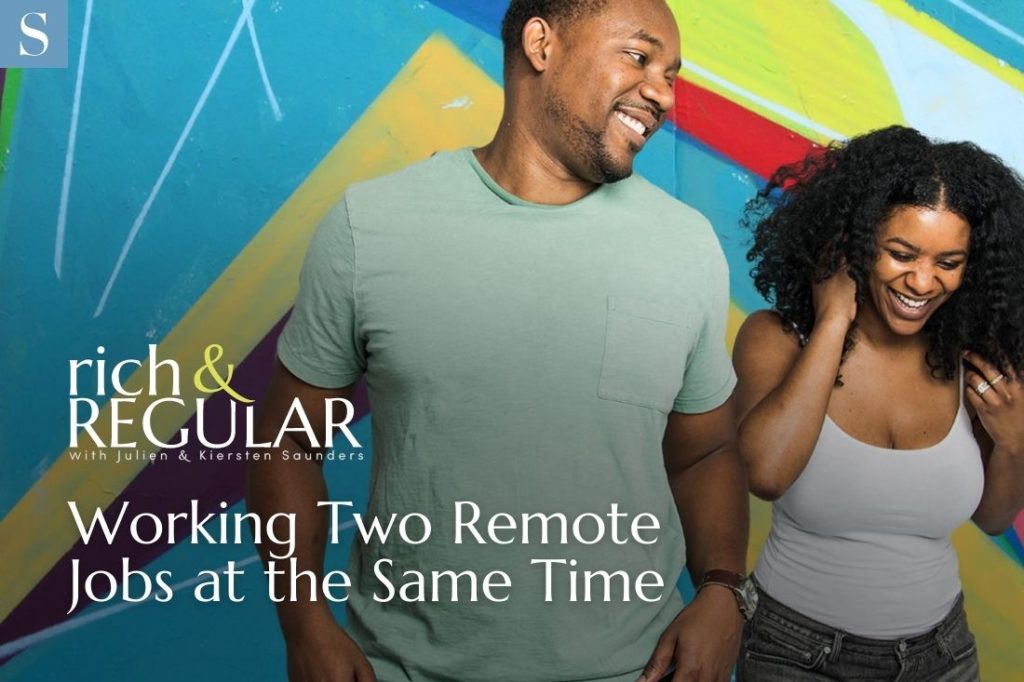Many people have made ends meet or achieved short or medium-term financial goals by working a full-time job alongside a part-time position or by working multiple part-time gigs at one time. Still, working two full-time jobs simultaneously (also called being over-employed) and the two paychecks that come with it is gaining popularity since the pandemic and the rise in working from home.
There can be multiple benefits, including an increased salary, a potential choice between health benefits, life insurance, retirement plans and the ability to take back some of the power from companies that haven’t been very loyal to workers over the past decades. Working two full-time positions might seem like a good idea, especially if you have the time to devote to both roles, but it’s not something to undertake lightly, and you need to be smart about how you go about it.
Rich & REGULAR with Kiersten and Julien Saunders is no longer releasing new episodes on the SUCCESS Podcast Network, but you can still listen to the full conversation below.

Why work two jobs?
Many of us have gotten used to full-time employment plus a side hustle or part-time job to help pay the bills, pay off debt or save for a big goal, like buying a house or retiring early. It’s not necessarily something we like to do, but it’s usually socially acceptable. The idea of having two full-time jobs, on the other hand, almost seems taboo or like you’re gaming the system. That’s starting to change as the pandemic has redefined work and the roles people are willing to take on.
While it’s usually not illegal to work two full-time jobs, you must treat both opportunities with respect. You’re still employed for specific tasks at each company and need to deliver and adhere to company policies and ethics standards. Do your homework and check your employment contract (if you have one) for a non-compete clause or limiting language. You can also discreetly check with your HR department about any rules regarding additional employment.
If you do decide to add another position, consider the following:
Find the right second job for you.
Finding the right second job can take some time. You need to find the right match for your skills, but you also need to make sure you can handle both jobs’ mental and physical demands. If there’s a physical component to one position, such as being in an office or on a job site a couple of times a week, does that allow you enough time to complete the tasks for the second position? Likewise, if you develop proprietary software or information for a company, it would probably be unethical to work for one of its competitors and develop similar projects or products.
Before you accept a second position, make sure you know the ins and outs of both roles, including the company cultures, major competitors and any ethical standards your industry adheres to.
Establish your schedules for each, and keep them separate.
Once you’re over-employed or have some combination of W2 and freelance employment, develop a schedule that lets you give the necessary amount of time to each job. You need to allow enough time for both positions, with some cushion, when one job is busier than the other.
It’s also important to remember to find time to rest and recharge. While you might be able to maintain a frantic pace for a couple of months or longer, you are more likely to burn out faster and for a more extended period than if you take time to recharge your battery along the way.
As you work, make sure you also focus on eating well, exercising, drinking water and taking care of your mental health to help your body and mind stay in top shape and accomplish your goals.
Use time efficiently and effectively.
If you’re going after two full-time jobs, you know you’re probably in for a lot of time in front of a computer. Ensure that you use your time efficiently to complete projects and tasks for each employer and to help keep you out of a perpetual state of catch-up, robbing one position of time to complete tasks for another.
Consider places in your life where you can save time, like batch cooking for the week or doing laundry or light cleaning as a break between work tasks to help you manage your day. Be conscious about the functions you perform for each, and keep separate to-do lists. Be sure, as well, that you don’t mix up communications or projects for each company, especially if both companies use the same communication methods like Microsoft Teams or Slack channels.
Have a clear goal and exit plan.
Ensure you know why you’re working two positions and have an exit plan for one or both of them. If you’re working to pay off debt or rapidly increase your savings, keep that in mind to help you manage when things get complicated. Even if you don’t have a family or other obligations, working two full-time positions is stressful, and it’s important to remember that it serves a broader function in your life.
Additionally, have an exit strategy and timeline for one or both positions. You may only work the extra job for a few months as you transition from one place to another or keep it for years because it serves your needs. Remember that life’s goal is not to spend all of your time working.
Final thoughts
Working two full-time jobs probably isn’t for everyone, but if you decide it’s what you need to do, develop strategies that can help you keep both positions moving forward and still give you the time and space you need to recharge. Remember that working all day and night isn’t feasible in the long term, and it’s essential to keep what you’re working for in front of you to help you keep your momentum when things are hard.



